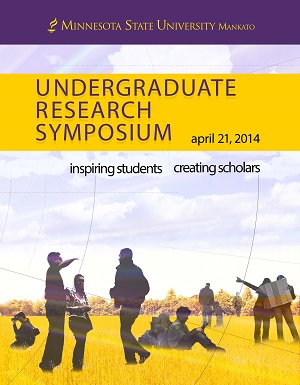Photodegradation of Roundup Ready and Reduced-Lignin Corn Stover During Spring Thaw
Location
CSU Ballroom
Start Date
21-4-2014 10:00 AM
End Date
21-4-2014 11:30 AM
Student's Major
Biological Sciences
Student's College
Science, Engineering and Technology
Mentor's Name
Christopher Ruhland
Mentor's Email Address
christopher.ruhland@mnsu.edu
Mentor's Department
Biological Sciences
Mentor's College
Science, Engineering and Technology
Second Mentor's Name
Alan Mickelson
Second Mentor's Department
Biological Sciences
Second Mentor's College
Science, Engineering and Technology
Description
Litter decomposition is one of the largest contributors to terrestrial biosphere carbon fluxes and nutrient cycling. Photodegradation is the breakdown of plant litter via solar radiation that may increase decomposition rates and lead to changes in carbon and nutrient cycling between plants, soil and the atmosphere. Decomposition of plant litter in the winter is mainly driven by microbial factors, which could prime photodegradation during spring thaw events. Litter degradation could be accelerated by ultraviolet (UV) and visible wavelengths. Lignin strongly absorbs UV radiation, and litter that contains high concentrations of this polymer may be more susceptible to photodegradation. In addition, litter with high lignin content has been shown to be recalcitrant against microbial decomposition and may be slow to break down. The Brown Midrib (BMR) mutation in Zea mays (corn) with reduced lignin content is commonly grown in Minnesota for an ideal forage feedstock. After harvest, corn remnants are often left on the field to decompose over winter and the following spring. We examined the role of UV in photodecomposition of BMR and Roundup Ready corn stover. Litter was placed in UV-transparent and UV-attenuating litter bags in a Southern Minnesota agricultural field. We examined mass loss of litter over a 12-week period and measured concentrations of cellulose, hemicellulose and lignin with a fiber analyzer. Our results should help elucidate the role of photodecomposition of corn stover in agricultural settings.
Photodegradation of Roundup Ready and Reduced-Lignin Corn Stover During Spring Thaw
CSU Ballroom
Litter decomposition is one of the largest contributors to terrestrial biosphere carbon fluxes and nutrient cycling. Photodegradation is the breakdown of plant litter via solar radiation that may increase decomposition rates and lead to changes in carbon and nutrient cycling between plants, soil and the atmosphere. Decomposition of plant litter in the winter is mainly driven by microbial factors, which could prime photodegradation during spring thaw events. Litter degradation could be accelerated by ultraviolet (UV) and visible wavelengths. Lignin strongly absorbs UV radiation, and litter that contains high concentrations of this polymer may be more susceptible to photodegradation. In addition, litter with high lignin content has been shown to be recalcitrant against microbial decomposition and may be slow to break down. The Brown Midrib (BMR) mutation in Zea mays (corn) with reduced lignin content is commonly grown in Minnesota for an ideal forage feedstock. After harvest, corn remnants are often left on the field to decompose over winter and the following spring. We examined the role of UV in photodecomposition of BMR and Roundup Ready corn stover. Litter was placed in UV-transparent and UV-attenuating litter bags in a Southern Minnesota agricultural field. We examined mass loss of litter over a 12-week period and measured concentrations of cellulose, hemicellulose and lignin with a fiber analyzer. Our results should help elucidate the role of photodecomposition of corn stover in agricultural settings.
Recommended Citation
Magnusson, Erika. "Photodegradation of Roundup Ready and Reduced-Lignin Corn Stover During Spring Thaw." Undergraduate Research Symposium, Mankato, MN, April 21, 2014.
https://cornerstone.lib.mnsu.edu/urs/2014/poster_session_A/23




